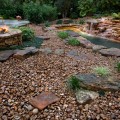Tips about Drought Resistant Shrubs
Drought resistant shrubs offer you low-maintenance curb appeal.
Using species that are either native to Texas or non-invasive to our area is ecologically wise. In some ways it helps restore elements of our original, indigenous ecosystem. It also works very well for conservation by requiring Houston residents to use far less water than would normally be needed to maintain their curb appeal during our long, hot summers.
To understand what these shrubs actually are, we have to get a good, sound grasp on what it means to be “resistant” to drought. The term is used loosely, and in several different ways, by a variety of landscaping designers and garden experts. To quibble over definitions is pointless. Essentially, what we are talking about in practical terms is the ability of a shrub to either protect itself against dehydration or store water within itself in a way that minimizes dehydration.
Looking at drought resistant shrubs from this perspective will cause us to quickly look beyond typical desert landscapes. There are many species of small trees and bushes that do not grow anywhere close to a desert, but still live in areas that occasionally see long periods of summer pass without a single drop of rain. Examples include plants from Central Texas, the Post Oak Belt, the Edwards Plateau, and even more vegetative environments in North Texas. This is just our state alone. Consider all the places in America that often experience droughts and you will always find some bushes and trees that have evolved a way to handle it.
Many of these adaptive traits also make drought resistant shrubs highly attractive. Many have a silvery appearance to their leaves. Some look almost gray because tiny hairs grow out of the surfaces of their leaves. These hairs reflect light and heat and actually create a form of shade for the leaves themselves. Moisture loss is minimized because only a portion of each leaf is ever exposed to direct sunlight at any given point in time.
Drought resistant shrubs with this characteristic look great planted in the midst of ferns and foliage rich ground covers. Many of these species can also be used as foundational plantings in gardens. It depends on what type of design we are creating for you. There are so many species to choose from that we can always find something that compliments any style of home architecture and works as a major element in the entirely of your Houston landscaping design.
This is because many drought resistant shrubs also have waxed leaves that look shiny in the light, and many others have leaves that are either noticeably small or variegated in shape. All of these adaptations are designed to prevent the plant from losing water. It turns out that what works so well for evolution also works very well for Houston landscape designers when it comes time to match a plant’s appearance to the geometry of a hardscape, the tree line near a stone wall, or the motifs of the architecture of a house.

